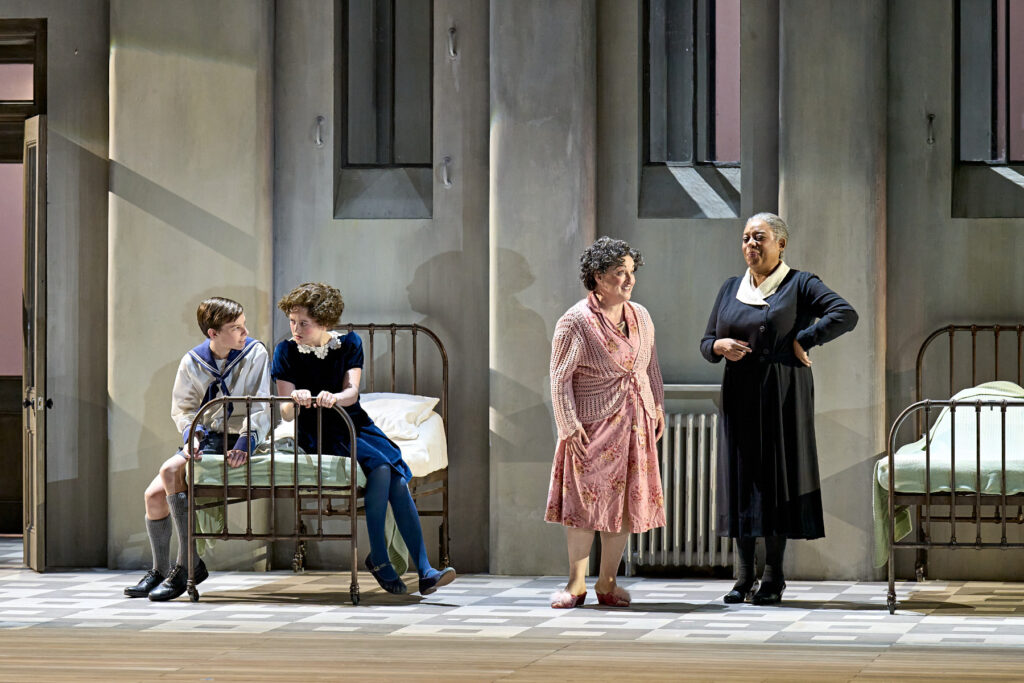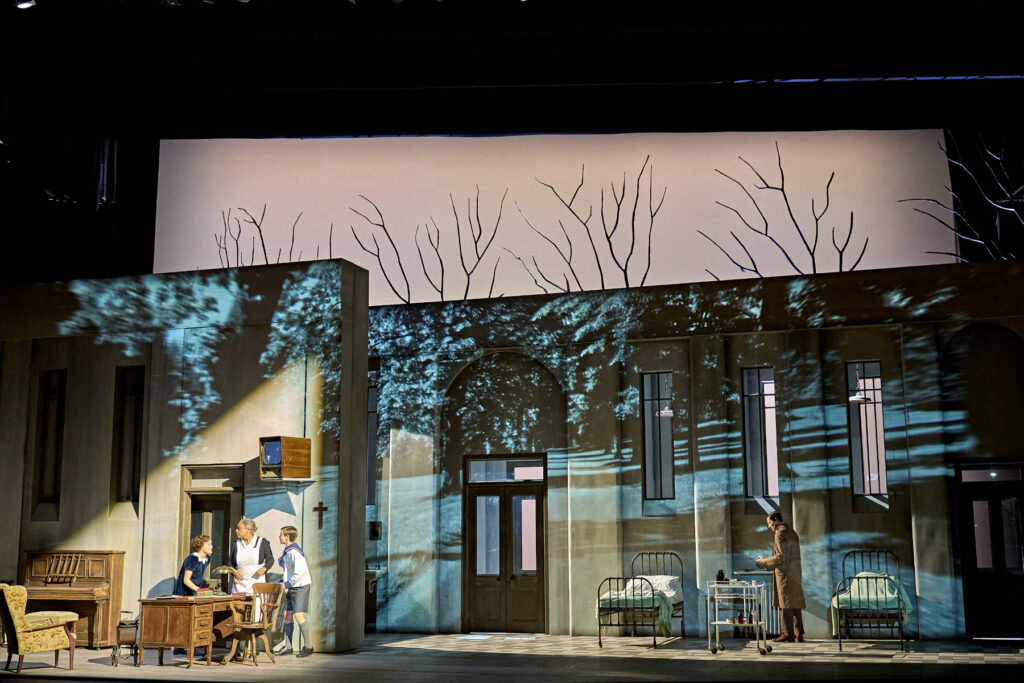Henry James’s 1898 novella expresses far more than the blurred lines arising from ghostly apparitions or the absence of moral absolutes. In Britten’s darkest opera the composer removes some of the original ambiguity in respect of Peter Quint and Miss Jessel, yet the work remains a world of half lights and tacit implications which, since its Venetian premiere in 1954, have been subject to numerous interpretations. This new staging from English National Opera under the inspired direction of Isabella Bywater, who is also responsible for the sets and costumes, takes an imaginative leap into the 1950s and sets the work in a psychiatric hospital where we follow the tale of the unnamed Governess through a series of “flashbacks and hallucinations”.

This neatly adds to existing ambiguities. Unlike James, Britten and his librettist Myfanwy Piper make explicit the presence of Quint and Miss Jessel and give them parts to sing. There’s ambiguity in whether the Governess want to protect or possess the two orphaned children, and whether they are controlled by evil spirits or tarnished by abuse. Bywater adds another layer of ambiguity in the suggestion that the Governess – an “anxious girl out of a Hampshire vicarage” – has been traumatised thirty years previously by events at Bly, and that she was already of unstable mind before taking up her position there. Now confined within an asylum, Bywater asks if the Governess’s condition is the outcome of earlier experiences aggravated by a nervous vulnerability prior to her arrival at Bly, or whether she has imagined everything that was supposed to have taken place. Has her emotional insecurity, Bywater asks, imagined the ghosts of Quint and Miss Jessel? ‘But who would believe my story?’, she sings early on in Act Two. Are the ghosts an embodiment of their malign influence, or a just phantom arising from the atmosphere at Bly. Either way, another layer of ambiguity is added to the story’s collision of good and evil, innocence and knowledge.

With Bywater’s split set we see the past and present worlds of the Governess who we first encounter in one of the asylum’s two beds – the other half of the stage suggesting the institution’s entrance foyer and office. It is here where the Prologue unfolds, with Alan Oke outlining his “curious story” in the manner of a doctor reporting to a nurse (one of three actors) whose crisply starched uniform brings its own verisimilitude. A central divider makes way for the drawing room at Bly onto which Jon Driscoll’s flickering black and white video projections convey its tree-lined grandeur, damp cellar and looping staircases, the whole atmospherically lit by Paul Anderson, who also conjures monstrous shadows in Miles’s bedroom from a rotating night light. Within Bywater’s shifting framework characters glide across the temporal divide, at one point Quint appearing as a hospital porter and later mopping the floor of the classroom to evoke the lake, while Miss Jessel appears as a patient – both cannily prompting questions for us and the Governess relating to what’s real or imagined.

Alan Oke sets the standard vocally with a burnished Prologue, while Robert Murray (two separate tenors in this production) delivers his chilling melismas for Miles with jewel-like tone which simultaneously attract and repel. His co-conspirator Eleanor Dennis is a compelling Miss Jessel, forming a superb partnership in the “Ceremony of Innocence” duet when Quint brutally assaults her. Gweneth Ann Rand excels as the naive and over-burdened Mrs Grose, bringing to the role ample tones and a strong presence, seemingly turning a blind eye to the revelations about Quint and Miles. She is well matched by Ailish Tynan’s Governess – shuffling across the stage in a dowdy dress and slippers – who traverses wide-eyed eagerness to determined children’s saviour, her voice sailing across the stage with bone china purity. Holly Hylton (Flora) and Nicolai Flutter (Miles) give well-defined performances; they are outwardly charming but unsettling in their games with a sinister doll and toy pig. Just a shame the youngsters were placed too near the rear of the stage for Act Two’s “Benedicite” where the voices were too often obscured by the 13-piece orchestra, this last persuasively directed by Duncan Ward making his ENO debut. Altogether, a thought-provoking production with some exceptional performances.
David Truslove
Turn of the Screw
Composed by Benjamin Britten
Libretto by Myfanwy Piper
Cast and production staff:
Governess – Ailish Tynan; Mrs Grose – Gweneth Ann Rand; Prologue – Alan Oke; Quint – Robert Murray; Miss Jessel – Eleanor Dennis; Flora – Holly Hylton; Miles – Nicolai Flutter; Actors – Vincent Carmichael, Rachel Laird, Vita Pugliese
Director & Designer – Isabella Bywater; Lighting – Paul Anderson; Projection – Jon Driscoll; Orchestra of English National Opera; Conductor – Duncan Ward
Coliseum, London, 23 October 2024
Top image: Ailish Tynan, Eleanor Dennis, Victoria Nekhaenko, and Jerry Louth.
All photos © Manuel Harlan.